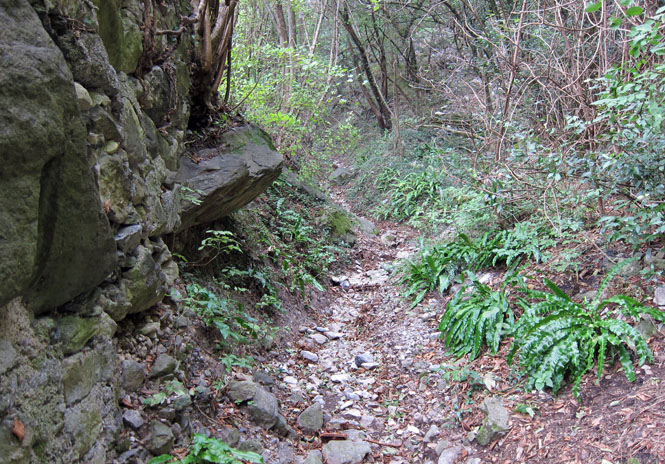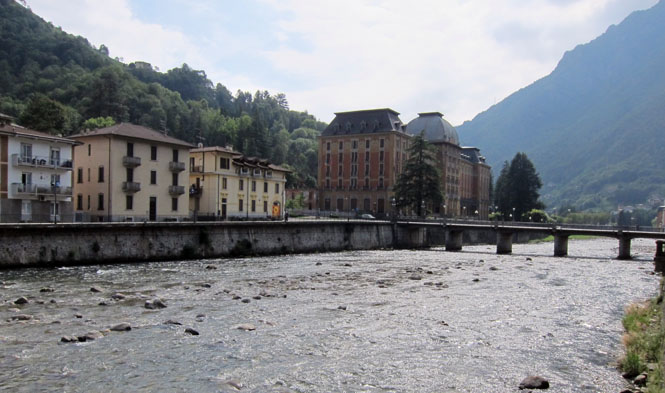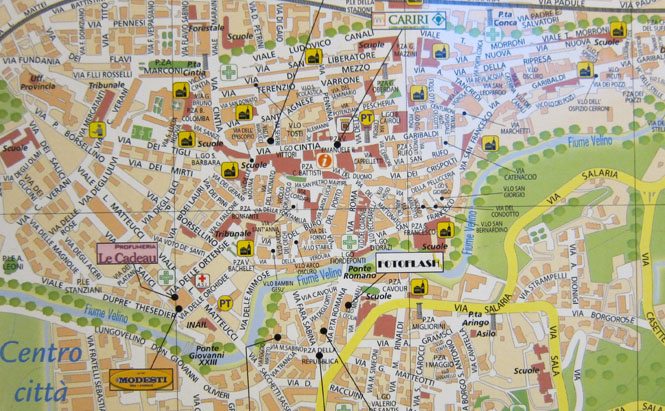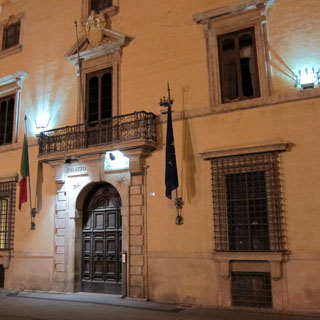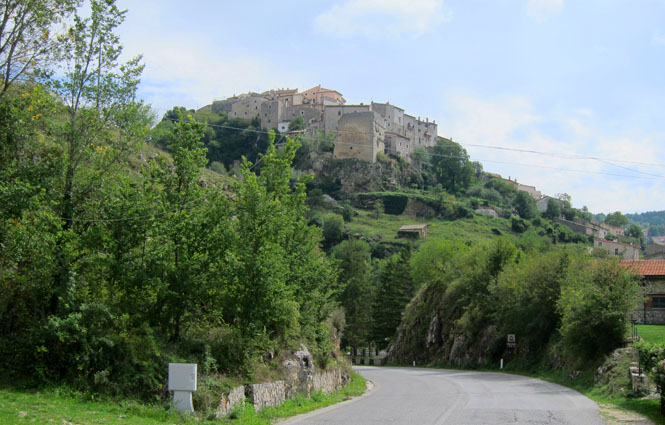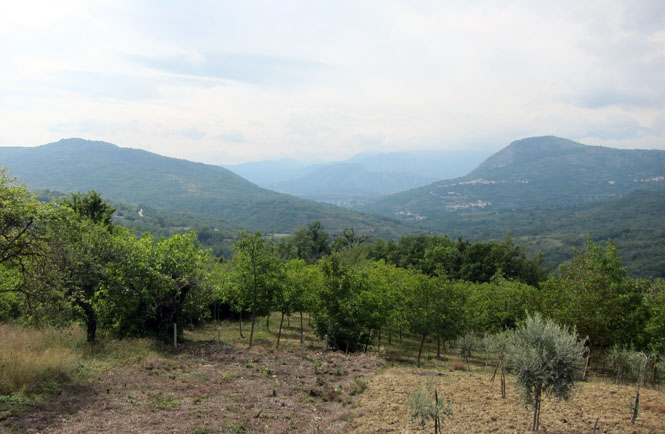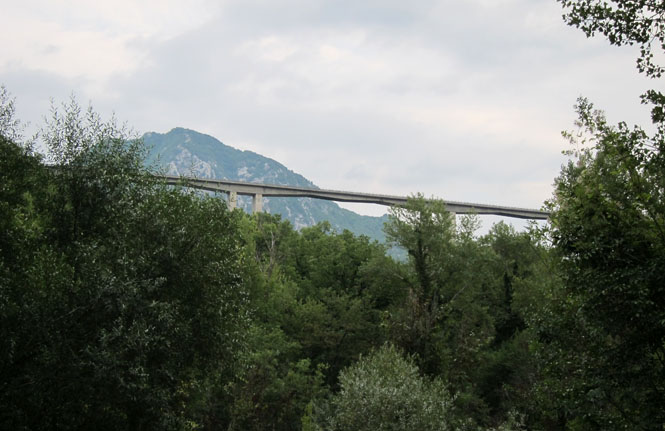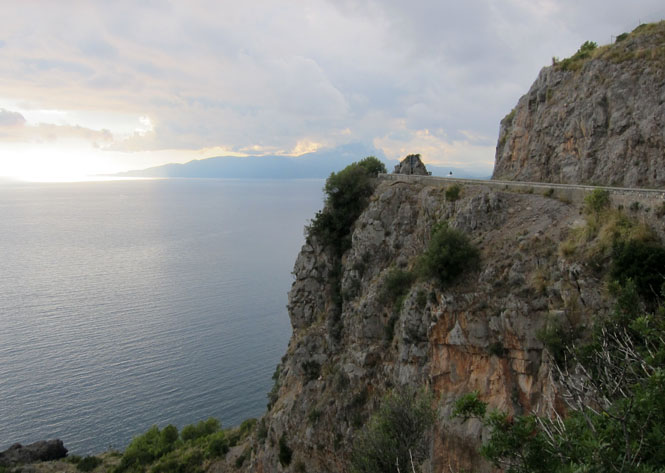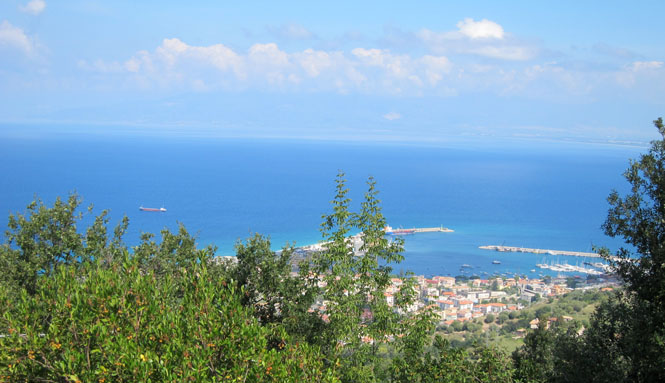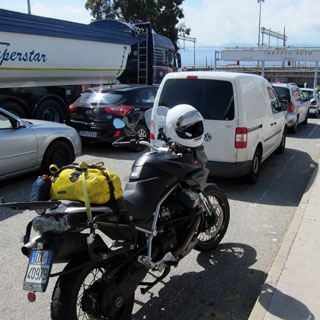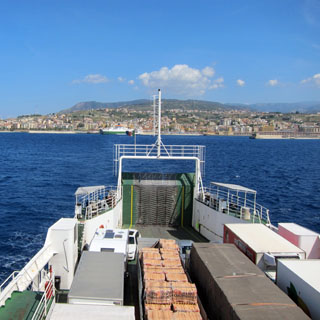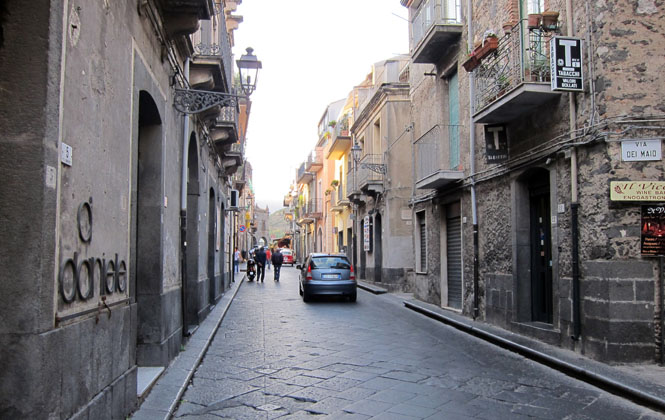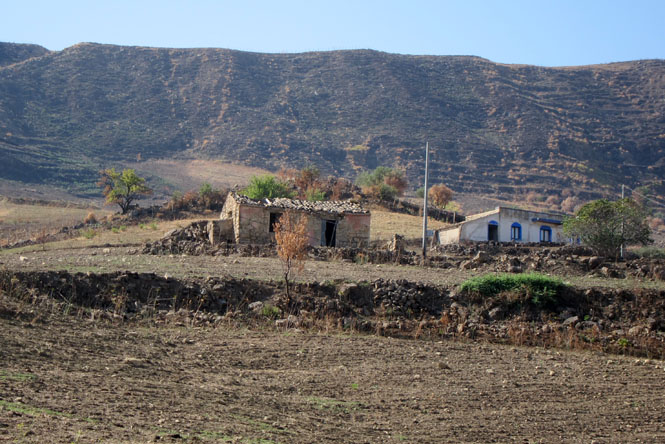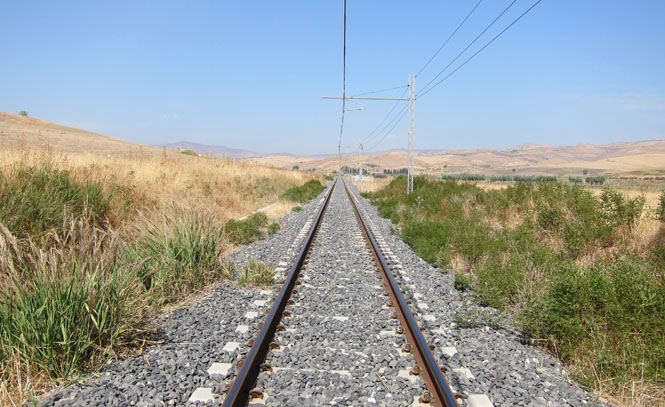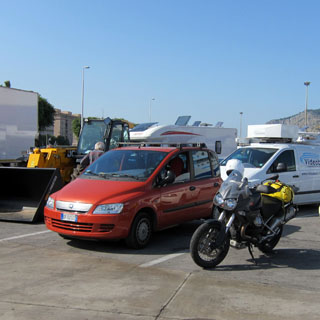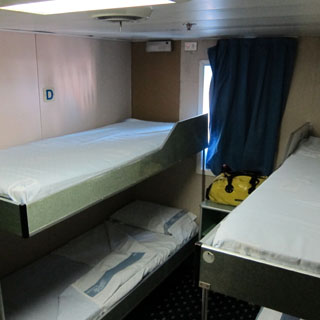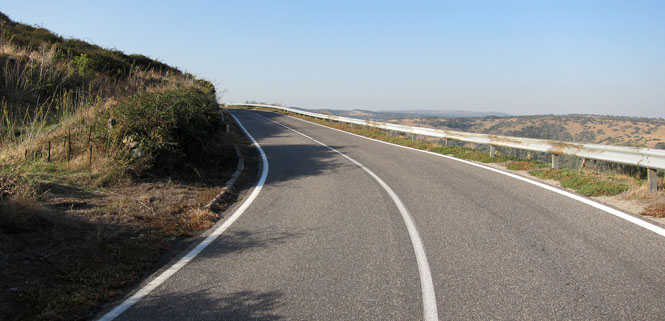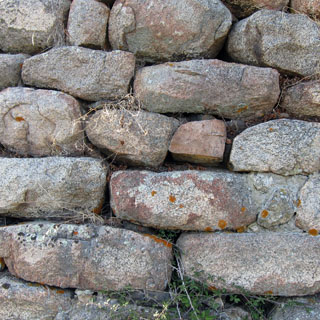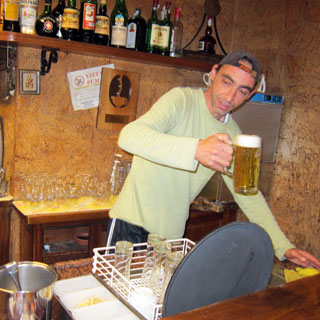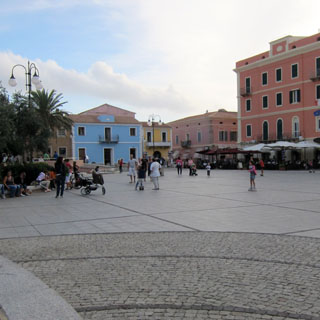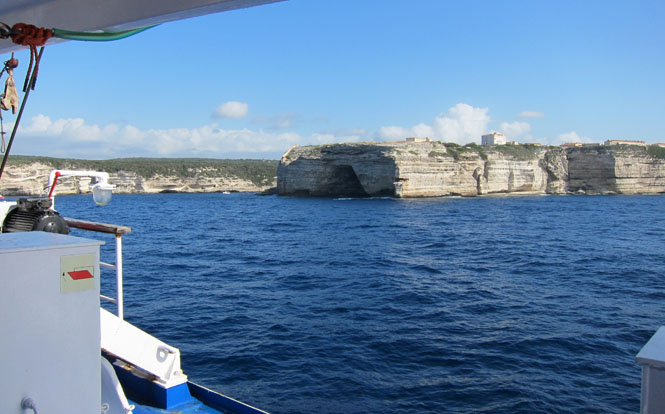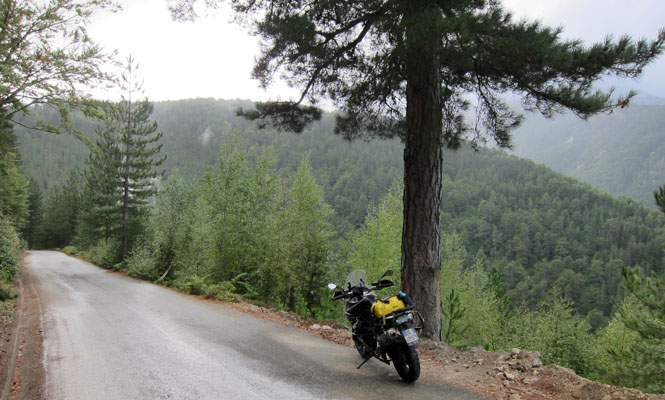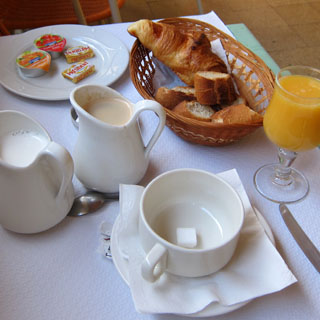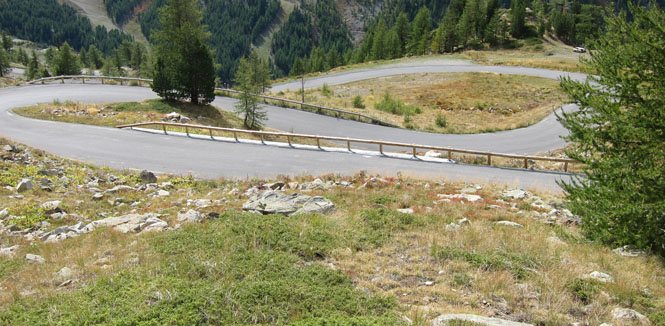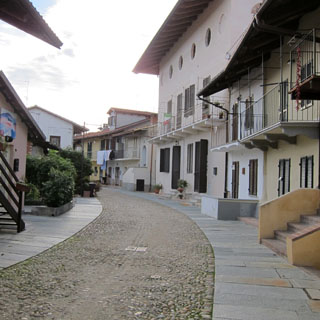



 September, 2012
September, 2012
Sunday |
Monday |
Tuesday |
Wednesday |
Thursday |
Friday |
Saturday |
9 September |
10 | 11 | 12 |
13 |
14
|
15
|
16
|
17
|
18 Rieti |
19 Telese |
20 Praia a Mare |
21 Randazzo |
22 Palermo * Ferry |
|
23 Cagliari Buddusò |
24 Santa Teresa Gallura |
25 * Ferry Ghisoni |
26 Basatia * Ferry |
27 Toulon Pollenzo |
28 Mandello |
29 Milan |
30
|
1 October | 2 | 3 | 4 | 5 | 6 |

 Europe Motorcycle Trip #7
Europe Motorcycle Trip #7
Shortly after last year's trip, I planned for two trips to Italy this year. The first one (in June) was through France and then to Wales. Therefore (it follows), this second trip had to be in a different direction.
At first, I thought I might just ride south the length of Italy, generally on one side of the Apennines, and then return back north on the other side--a long, skinny loop. Then it occurred to me that I might be able to string Sicily together with Sardinia and Corsica, which would make the trip more interesting (and avoid the less preferred out-and-back). All that remained was to check the ferry schedules to see if this would be possible. It was; it is.
 Texas
Texas
If you want to fly to Milan, one flight makes sense: Continental (now United) flight 44 from Newark. There are a few other choices to get to Newark.
The Houston airport seems most noteworthy for the miles-long walk (it always seems) to get to where you need to be--and that includes using their elevated train.
Waiting in the lounge.
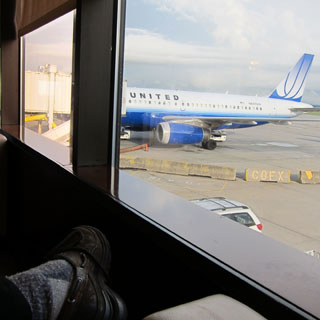
 New Jersey
New Jersey
My white B767 looks pretty generic.
The flight leaves in the evening, so you're fed dinner. An hour before landing, breakfast is served. In between, you've got to try to catch at least a few hours of sleep.

 Italy
Italy
Milan is one airport where you can walk all the way from the airplane to baggage pick-up and then walk out of the airport with only the pause to wait for the baggage handlers to catch up. Passport control is practically a pass-through thing, and there is no customs to bother with.
I scanned the train schedule on the wall and elected to take the bus. If your timing is right, the train will have you in Milan, faster and smoother. The advantage of the bus is that there is always at least one waiting at the curb with the driver in front selling tickets (it's cheap).

The bus drops you off at the side entrance of the Milan train station. There are lots of self-service ticket machines available to get the ticket for the regional train (they accept American credit cards).

I've always been impressed that these trains cruise at 80mph.
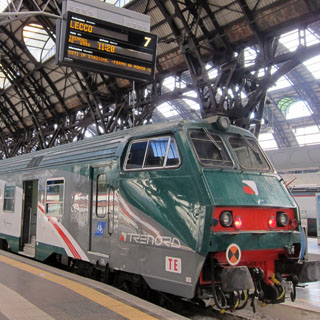
In general, I prefer to stay at a different place prior to starting my trips. But, Lecco is such an easy place to start that I returned to the same hotel that I used a couple of years ago.
Hotel Albert faces Lake Como and it is an easy walk from the train station.
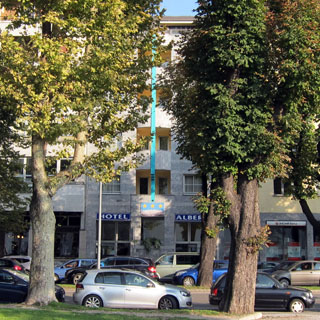
This is Saturday, so there's a busy open market selling food and all sorts of other things of varying quality (with possibly genuine labels).

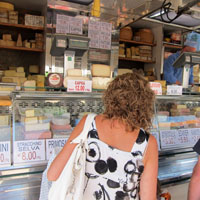
The Azzone Visconti bridge was built in 1338.
Ah... Lake Como.
That's the San Nicola tower in the background (San Nicola is the patron saint of Lecco).

Bits and pieces of the original fortified walls around Lecco are still visible.


My day started Friday before sunrise in Kansas and finished after sunset, Saturday on Lake Como.
A display of vintage racing motorcycles was being set up the next morning.


Yes; everything else might be rare and valuable, but when shown next to an original Moto Guzzi V8 Grand Prix racer from the fifties, they are common. That Guzzi is a stunning achievment.






One of the few plans I had for this trip was to take the ferry to Onno, then find a trail that would take me to the top of the mountain that divides the two legs of Como. I wasn't sure where to look for the trail, but I knew that there just had to be something. Had to be.

These lovely passenger ferries were launched in the mid-fifties.

Onno is ten or so miles north of Lecco. It's actually just across the lake from Mandello del Lario (south of Bellagio).


My idea was to just walk through town to the base of the mountain cliff and look around for a trail head.

Yes; there is a trail. In fact, it looks like there are three paths to the top. Not knowing one from the other, I picked trail #1.
This was sometimes a difficult trail to follow. There were occasional painted marks, but not nearly enough. For the most part, I think I was on the right path all the way to the top.

In several places, the trail was so steep that a chain had been provided. Without the chain, you'd be grabbing for trees and bushes and an out-cropping of rocks and would likely still be on your knees much of the time. I always gave the chain a good tug before trusting it--they've been here many years.

Part way up.
Is this really the trail? Well, here's the chain, so it must be.

Really? Yes. Perhaps you can see the chain near the center (above and to the left) of the photograph.
It always was reassuring to spot one of the painted trail marks. I routinely looked behind me as there might be a painted mark facing the other way.

Slipping would be bad.

It's time to sit down and rest. It seems I'm never going to reach the top. I should have brought some water...
Looking back across the lake to Mandello del Lario.
Goats! Don't follow me; I'm more lost than you...


At the top I was rewarded with a paved road. Walking never seemed so easy. Then I plunged back down along a different path.

While still quite steep, the path down was pretty easy to follow and didn't involve any chains. This was pleasant going even if my knees were objecting by the end.
I think I'll just grab this tree while I walk around this corner. It would be a long, rough, slide down the hill.

There were a few rough one-room stone buildings down lower. What an effort to hand-locate all these stones to pave the path.
I'm heading back to Onno. Just 3 km to go; almost there.

The ferry back to Lecco arrived just as I reached the dock. I didn't even need to pause. These are the mountains on the other side of the lake. Perhaps next time I'll look for a trail to the top of this side. It's a certainty that there will be several.
I'd have to have pizza at least once on the trip. This is it. In Italy, only children have their food sliced for them.
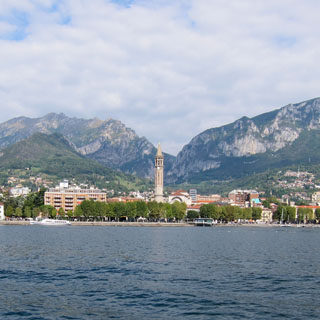
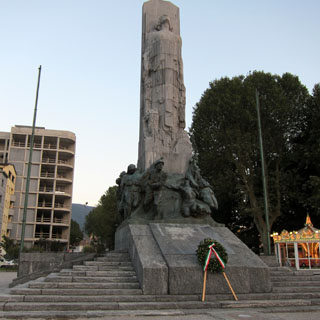
Monday morning I'd catch the train from Lecco to Mandello del Lario. This is now routine: unpack both yellow duffle bags I've been carrying, and repack into the smaller. I'd be wearing the riding suit, boots and helmet, so the one bag was more than sufficient. As always; straps, not bungee cords.
Additionally, I attached the small Garmin battery-powered GPS to the handle-bar. I used that on the earlier trip this year and it was very helpful. I'd need it for this trip.
This is the same bike I had back in June (and it probably still had some of my same grime). Nicola had already made sure that the windshield and seat were adjusted the way I like, and he had removed the saddle-bags and the rear trunk.

The upper limit of Lake Como. I stopped here just to make sure everything was in order and I had a destination.
Other than the general direction of riding all the way down Italy and across to Sicily, I had no preplanned route. However, I did want to take a little detour to ride over San Marco pass, which is to the east of the lake. The pass isn't really on the way to anything, so I'd need to take some effort to get there. It's a lovely route with virtually no traffic.
The road is about 1½ lanes wide. On a motorcycle, that's hardly anything to think about.
The cool air is nice as the road descends through the clouds. It was going to be a warm day.
San Pellegrino Terme. The large brick building is a hotel.
South of Bergamo the Po River valley is flat and agricultural. It hardly made much difference which roads I took, just so long as I headed mostly south and east.

Cingia de' Botti. Any road is fine, so long as it isn't the Autostrada.

Reggio nell'Emilia is between Parma and Modena. This sixties-looking hotel would work just fine. It's close enough to the center of town that I'd be able to walk. I've learned that in the off-season (which is now), the price of a three-star hotel such as this one isn't going to be any different than a lesser hotel.



Prawns and noodles followed by some sort of fish.

Getting through Modena and Bologna along the secondary roads was not looking like much fun. Traffic is a mess and this is the more industrial area of Italy. The autostrada was the best choice. I'd put down some quick miles and then take the exit at Imola (shown).
The days when I could swipe my credit card at an Italian pump are gone. I'm afraid our American cards are not welcome in these machines. However, if you fill at the full-service pump you can still pay the man with your old-fashioned credit card--he probably still has the equipment.

Dropping south into the countryside of Emilia Romagna was such an improvement over the industrial landscape I'd been riding all morning. This is a gorgeous area.
Modigliana. Let's stop and look at the map to figure out where I'm going. Yes; I use a GPS, but I never set my destination all that far away that I don't need to keep referencing the map to decide my next plan. With this technique, it's a rare thing that I would ever actually reach the destination that I've plugged into the GPS. Generally, I change my mind well before I reach that point.
The GPS is most useful for getting me through a town (few of which have any road signs).
I might have been on this road for an hour without seeing any traffic.
How many centuries ago did somebody clear enough area to create these farms?
Galeata.
I found a place to eat at the corner of that orange building (above). It's sort of a pizza on flat bread. No idea what it's called; but, it's a good lunch (with whatever is in that glass). I'm always looking at maps--my standard reading material at mealtime.
I've come to expect this. Midway through the second day, fatigue hits me. I'll take an hour for a nap, and that solves the problem for the rest of the trip. Spread open, my riding suit makes a good blanket, and my gloves and silk scarf make a good pillow.

Emilia Romagna has some of the best roads in Italy.
Papigno.
I reached Rieti at a good time to stop. But, man, this was a difficult place to find and reach a hotel. The center of town is just a maze of ultra-narrow roads that are often one-way that it seemed impossible that I'd ever figure it out. I'm almost convinced that there are some areas of this town that cannot be reached.
But, I did find something eventually, and the Europa Hotel is a good one. Notice the cars parked "across the street" from the hotel entrance. This might have been the nicest hotel room of my entire trip.



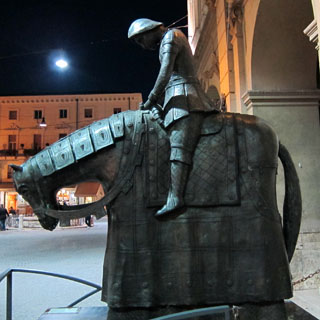


I'm getting deeper into some rugged mountains.

Gioia dei Marsi is at the upper end of an unexpectedly flat area surrounded by mountains. There was a fair amount of burning (stubble from crops?) so the air was quiet hazy.
Gioia Vecchio and the road to get there.
Opi. The road I'm on skirts around the high hill, so I didn't ride through Opi.
Dense forests of hardwood trees.
Villetta Barrea.

Barrea. It becomes expected, but the towns are generally built perched at the top of hills. The flat valleys are where the crops are grown, but the people live up high. I can only guess that this was a pretty violent place at one time.
Alfedena. The road I'm on will descend down to the town.

Near Acquaviva D'isernia.
A friend grew up in the small town of Foresta, near Isernia. He still has relatives who live there. I'd stop for a short visit to extend his greetings, and then continue riding south.

Aunt Luigina is a wonderful woman who insisted that I stay for dinner at the very least; but, I just couldn't stay... Perhaps, the next time.

Cousin Adelina and her husband Antonio showed me around the town.


It doesn't take long to walk around the town of Foresta.






Cerro Al Volturno is just down the hill from Foresta.
There's been some remarkable road construction in the last several years.
This is not my favorite kind of road (heavy truck traffic for one thing); but, sometimes you need to put down some miles.
The Grand Hotel Telese is a 19th century hotel that isn't the sort of place that I would normally be staying at. But, as I have said, in the off-season every hotel is pretty much priced the same.



Riding south and towards the west, I'd be picking up a series of obscure roads. Just so long as they pointed in the general direction they'd work fine.
Near Castello del Lago.

All I can figure is that everybody is someplace else on a much more modern highway. In any case; they're not here.

On occasion, I'd have doubts that the road would continue to be paved; but, that was never a problem. In Kansas, you cannot trust a poorly paved road not to turn to dirt. But, I've found in Europe a paved road will not let you down (provided you're not riding straight into the Alps)

There's the Mediterranean. Let's go there.
Agropoli.
Sea creatures, again, and some sort of mushroom and meat dish.

80 kph? Nobody goes that slowly.
Near San Severno.

It turns out that the road through this canyon is closed (for reasons not clear), so I headed into the hills on a variety of smaller roads. Eventually, I did end up where I wanted to be.
And, where I wanted to be is here. Notice the road tunnel near the water's edge.
Lentiscosa.
The lines that you can just see along the hillside? Stone walls and terraces. The hills are covered with them.
San Giovanni a Piro.
Sapri.
This is a pretty crazy road. Lots of short tunnels, lots of hanging cliffs. Miss a turn; get wet.
Praia a Mare. I'd stay at the Joli Hotel. It was not a good idea to keep that window open. The next morning my forehead and right side of my face had a red polka-dot appearance that would remain for the next several days.

I'd see a number of these pillboxes on this trip. You wouldn't want to be the soldier posted inside this; but, then you wouldn't want to be the soldier told to attack this, either. I assume this dates from the second world war.



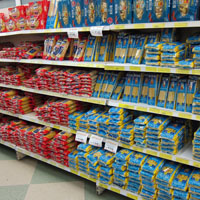
I'd be finishing out the ride south by riding along the coastline.
Vibo Marina.
Villa San Giovanni. While I packed a schedule of various ferries between Sicily and Sardinia and between Corsica and the mainland, I never bothered looking up the ferry options across the Messina straight. That's a good thing; because I would only have been confused.
As I rode to the terminus, there were signs for three different ferry companies. I picked one and stayed with it. Tickets were for sale at the biglietteria, and then I got in line. It was not a long wait.

It was just less than an hour across. I was impressed by the amount of shipping traffic through the straights. No wonder people have been fighting over this particular bit of water for thousands of years.

 Sicily
Sicily
Messina. These people are crazy! This is a fair-sized city, and the ferry puts you right in the heart. Broad boulevards, but no lane stripes. Cross streets, but no signals and no round-a-bouts. It's a free-for-all. I took the first street heading south and just kept pushing away from whatever looked busy.

In time, I hit the autostrada, and that whisked me away from the problem.
I already knew that I would need to make fairly good time while in Sicily. This was late Friday, and I needed to be in Palermo by Saturday evening to catch the weekly ferry to Sardinia. There was a backup ferry that left the next day from Trapane, but doing that would put needless pressure on the rest of the trip. I needed to be in Palermo.
Fiumefreddo di Sicilia. I wanted to see Mount Etna, and in general, it made sense to ride across the central spine of Sicily instead of staying on the coast. Many of the attractions are along the coast; but, I suspect old rural Sicily is in the middle.
Linguaglossa.
If you only compared the color of the towns, you would know you were in southern Italy and not the north. The paving stones of this sort are common. Slippery when wet; but, that wasn't a problem on this trip.
Stones and more stones. There is an abundance of proper-sized stones for making fences and houses. Just walk out into any field and you'll have all you need. Over the centuries great piles have been created, and still the fields are littered with stones.
Randazzo is north of Etna. This hotel was built in the early fifties by the Agip company (home of the six-legged dog). Evidently there were a number of travelers hotels built as part of their chain of gasoline stations. That quaint idea is gone, but the hotel remains (as does the Agip station out front)




I waited a good while for the clouds to clear. I'm hoping that this isn't to be my only view of the mountain.

Good. The next morning is clear. This shot of Mt Etna is from near the town of Bronte. I once had an idea of riding towards the summit and perhaps even hiking to the top, but that will all have to wait for another trip.
These volcanic plugs are pretty common, as are large lava fields. There have been times when you would not want to be near Mt Etna.
Riding west along some narrow and remote roads.

If you build a house (or a barn) by stacking rocks, it will be there for many years.
Centuripe. As elsewhere, you build your towns on the tops of the hills; not, at the bottom.
I was careful with roads like this. At any turn, you might find the pavement broken up. The Guzzi Stelvio is perfect for this sort of thing.
Agira.
I'd try to memorize the various towns in my direction. The GPS was a huge help to keep me in the right direction, but I never took its commands as anything other than a polite suggestion.
Thé is tea and pesca is peach (not fish--that's pesce--which would be a horrible flavor for tea).

Some really nice swoopy roads along here. The lack of any shoulders is annoying, but I found the roads so empty that I could just park in the lane without much worry if I needed to take a photograph.
I understand the things on the left, but do people eat the things on the right?
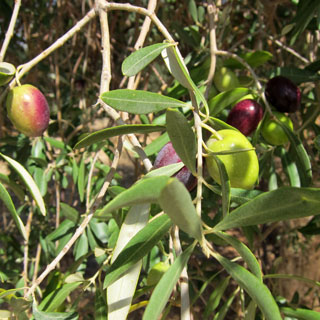
I can't fault the signage in Sicily with the exception that the road number is rarely shown.
Notice the extended elevated portion of the autostrada. Amazing. Why is it done that way? I've no idea. It looks expensive.
Maintenance might be costly in thirty years, but for now, it's very impressive.
Is a train with just a single car still a train?
It's either an abbey or a large barn. But, of course, it's on top of the hill.
Palermo. They were crazy in Messina, and they are crazy in Palermo. In between these two cities, I didn't find the road manners to be all that bad. Most remarkable are the cross streets that are uncontrolled. Madness. Anyway, I found my way easily enough to the ferry terminal. With not too much more trouble, I also found the building where the tickets are sold.

This ferry would also be tonight's hotel. A nice arrangement that makes this whole trip possible.
Evidently, the Mediterranean is never as rough as the channel or the north sea. It wasn't much more than twine that the bike was secured with.

The nightly washing must always be done.

Goodbye to Sicily.
We're sailing directly west.

 Sardinia
Sardinia
Cagliari is a good-sized city that I did my best to skirt around. First thing I noticed is that the drivers are not crazy! Perhaps it's the French influence from the north.
Seems a bit greener than Sicily.
This radio dish (Sardinia Radio Telescope) was rotating on its turntable faster than you'd think appropriate for whatever it is used for--particularly since the angle of tilt was not changing. Maintenance, perhaps.
Seemed sort of like southern California at times.
I guess I'll just stop right here.
Just like Sicily; Sardinia is the land of rocks.
Left-right-left-right. There are some terrific roads.
Ballao. I needed something to eat, but in Ballao, I didn't stop at a place that had much more than this. No matter; it was good. No peach tea, and certainly no wine.
Huge rising cliffs. At times you wondered how the road would get through.
Not an easy place to put a road.
Arbatax. A curious mix of rocks.
Something good with clams and then another fish of some unknown variety. The noon meal is taken seriously by everybody. I saw no fast food (and no fast eaters).

Some roads are wider than others. Nothing was ever less than this one, however.
Passo Silana had a continental flavor with all the motorcycles and the restaurant at the summit.

There will be more than a few zigs and zags before this road reaches the floor.
Dorgali.
We're in the middle of Sardinia.
Put a road across that ridge? Yes.

An ancient burial tower? Observation tower? I suspect any excuse to pile up rocks is enough. In other countries, the rocks might be pilfered over the centuries to build houses. Not here. Rocks are easy.
The
nuraghe [nuˈraɡe]
(plural Italian nuraghi, Sardinian nuraghes) is the main type of ancient
megalithic edifice found in Sardinia, developed during the Nuragic Age
between 1900-730 BC.[1] Today it has come to be the symbol of Sardinia and
its distinctive culture, the Nuragic civilization.
There is no
consensus on the function of the nuraghes: they could have been religious
temples, ordinary dwellings, rulers' residences, military strongholds,
meeting halls, or a combination of the former. Some of the nuraghes are,
however, located in strategic locations – such as hills – from which
important passages could be easily controlled. They might have been
something between a "status symbol" and a "passive defence" building, meant
to be a deterrent for possible enemies.

Buddusò. There have been a few other places (New Zealand comes to mind) when I was greeted with this offering at the front desk.







A house entranced designed by an eleven year old boy? In any event, it looks like they gave up.


Bottidda. If you can't build your town on top of the hill, at least you can build a guarding castle.

Foresta di Burgos. Whatever this once was, there isn't much of it left. Vegetation will always win in the end.



White donkeys. They were friendly.


Near Sindia. Another burial tower? A watch tower? Or, just another excuse to pile up some rocks.
Rocks, rocks, rocks.
Bosa (and Castello di Serravalle above the town). The color is unexpected.


That smaller building with the red roof on the left? That's where I would have lunch.
Rarely do I have a beer when I still have riding left to do, but I'd be here for a couple of hours.



Castelsardo. The castle is on top of the hill, and all the people's houses huddled around it.
Santa Teresa Gallura. I'd stay here for the night, and take the ferry across to Corsica the next morning.




I saw this painting (print) in a shop, and noticed one of my friends, the white donkey. I imagine they've been used on Sardinia for many years.

Breakfast at the hotel and then the short ride out to the ferry. The boat was there waiting.

 France
France
Time to switch to French.
 Corsica
Corsica
The trip across the Strait of Bonifacio was less than an hour and was smooth. The opening to Bonifacio was amazingly narrow. We fit.
Bonifacio. The ferry would dock at the platform on the right.
Sardinia had more trees than Sicily, and Corsica has more trees than Sardinia.

My plan was to turn inland early on, and then follow the spine of the island north. It was a good plan.
The French like dashed lines along the borders of their roads.


This is not the sort of road to go fast. There was no traffic. None.
San Gavino di Carbini. Time for lunch.

I sat at that first table you see in the background. A very pleasant day--a few sprinkles, but nothing objectionable.
If I see buffalo mozzarella and tomatoes on the menu, I'm likely to go for it. The other is some sort of vegetable lasagna that was more French than Italian (creamy sauce on everything).

Sainte Lucie de Tallano.
There's not much room for two cars to pass, but that won't happen very often on this road.
Zoza.
An impressive old road embankment combined with a narrow bridge.
Zérubia. It isn't often you see towns that begin with 'Z', but you will in Corsica.
Pigs on the road! Lots of them. They don't dart out, so they were not ever a problem. I kept an eye on them.

Cozzano. I had already noticed that fuel was not especially common in every town, so I took advantage of this.


I'm getting some occasional heavy rain. That's not all bad (I am dressed for it), but I dislike the wash of mud that sometimes drains across the road.
A rainbow!

Ghisoni. It's a bit earlier than usual; but, let's stop here for the night.
That phone booth in the room? That's the shower. Behind the red removable panel? That's, of course, the toilet.


Cows along main street (of course, it's not called main street). Cats are more the usual thing.


The bridge is for a walking path (which I took).


My breakfast the next day. A pitcher of coffee and a pitcher of hot milk. I poured them both together into the mug.

Crossing over the hills and heading to the coast. I'd still be following some pretty obscure roads.
I never worried when I just parked on the road. Sometimes I wondered if I hadn't somehow stumbled on a closed road.
Fort de Parciola, Vivario.

A view of the Mediterranean. In an hour, I'll be down there.
Belgodére.
Yes; there is a village on top of that hill.
Santa Reparata de Balagna. This is a very old church. Not much to say about the outside, but the inside is impressive.


L'Ile Rousse. There is a ferry that connects to the mainland, but there was nothing in port when I was here.
The red-checked table has cheese for sale.
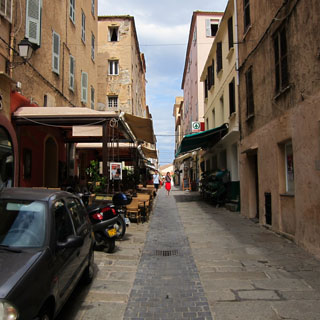

The color of the water was amazing. I didn't swim.
Crossing back over the top of Corsica, heading to where the ferry would be leaving from.
Patrimonio.
I don't know much about the battles that were fought on Corsica during the second world war. People died on this hill, fighting for it.

Basatia. It was more trouble than it should have been to find the building where I could buy a ticket. During the previous days, I was deciding which would be my destination port from Basatia. I had made up my mind that I would go to Savona, Italy, which would let me spend time riding through Piemonte, but at the (literally) last second, I told the ticket-agent that I wanted to go to Toulon, France.
This young couple had been spending a few days on Corsica before returning to their home in central France. We were waiting together the few hours until the ferry loaded.

It was an hour late, but eventually we did load. This time, I used my own straps that I carry to do a better job lashing the bike to the rail.

This cabin did not have a window as did the ferry from Sicily.

Goodbye Corsica.
Dinner onboard...

...and breakfast the next morning. That red car is a BMW Z1, which is mostly unknown in the U.S.

 France
France
Toulon. Why Toulon? Because I wanted to cross the pass (Col de la Lombarda) across the Alps into Italy that I had attempted to take a couple of years ago, but was unable because of snow. There would be no snow this time of year (I hoped).
Blasting up the motorway to Nice, and then turning north on much more interesting roads.

When there's a river edged in by cliffs, it cannot be easy to insert a road.

Ever vigilant. Was this French outpost ever in action?

Isola 2000 is just short of the summit on the French side. It's a ski resort, and one can assume that the "2000" in the name refers to the altitude. I think most all the people in the small restaurant were maintenance workers for the resort.
No; I have no idea what I ordered. It was good, and I got the always-welcomed bowl of fresh Parmesan cheese.

It is a steep climb to the top.
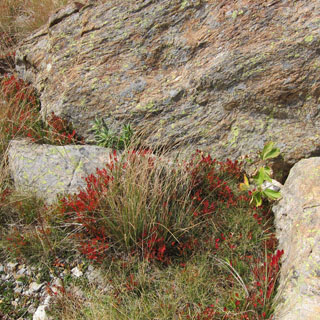
 Italy
Italy
I am well above the tree line, now. I understand why this road would be closed if there's much snow. Snow removal would be very difficult. Likely the resort on the other side of the border is kept open, but the Italian side is probably ignored.
Oh, man. Turn, turn, turn. Down, down, down.
2010 (closed and more water in the stream) and 2012 (open). In hindsight, it was for the best that I didn't take this route on that earlier trip. The road took much longer to ride than I had thought.
Ronchi. Just passing through. The idea was to say south in the mountainous region of Piemonte rather than the flat land to the north. A very good plan.
Pollenzo.

This is an old Roman town.
The church has clearly been rebuilt in a more modern style (it's all relative) in the last couple hundred years. This was once a royal residence of the kingdom of Savoy.
It is now the home of a culinary arts university.



It's remarkable. The curvature of the old coliseum is still to be seen in the roads of the town. And the center of the coliseum is now a vegetable garden.



Breakfast the next morning.
This is such a beautiful area of Italy.

Near Calghera. I'm riding all sorts of secondary roads.
Montelungo.
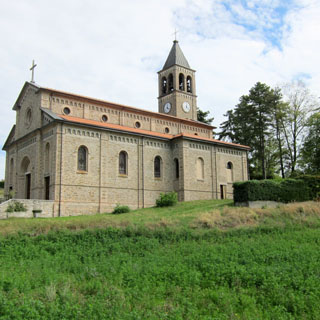
Nibbiano.
Grapes, grapes, everywhere grapes. The air smelled of grapes.
Badia Pavese for lunch. This was a very pleasant place to stop for awhile (there is nothing hurried about the noontime meal).


Mandello del Lario. I avoided the major highways back to Bergamo, and then took the well-marked road to Lecco and then to Mandello.

Another view of the terrific statue of Carlo Guzzi in the center plaza of town.

A quiet evening in Mandello del Lario.
Yes; there really is a motorcycle factory just a fifteen-minute walk from here.
Let's look back two weeks. This is Onno.
The trail I took starts to the left of that church tower and follows the spine all the way to the top. It's apparent from this, that some of the shots I took looking back at the lake were done at the very edge of a cliff that dropped a long way down.
The path coming back was over on the left and stayed in the trees the whole way.
Mamma Ciccia's is where I have always stayed the night of my return.
That's fish on the left, and a salad on the right.

Goodbye to the Moto Guzzi factory and Mandello del Lario.

Arriving at Milan.

I picked a new hotel for this trip. The Hotel Berna is vastly better than where I had stayed that last several trips. I'll definitely be here the next time.

These Vodafone ladies are advertising a Picasso exhibit (which I would see).

The Duomo. It's raining! That's fine. It no longer matters.



Biblioteca Ambrosiana (with a very good collection of Da Vinci's work--including the Codece Atlantico) and the Palazzo Reale di Milano (with the Picasso exhibit). Neither place allowed photographs.


A Milano street just north of the Duomo.



The Museo D'arte Marinara is a very old-fashioned thing with its paintings hung to the ceiling. It was not crowded.



..now, it is really raining hard. Good.
Reverse the process. Walk to the train station, catch the early morning bus to the airport.

On the Newark-Chicago leg, I'd be upgraded to 1st class, but there's no chance of that happening on the international leg. This is dinner.

Chicago on a clear afternoon.

It worked!
The only part of this trip that gave me any concern was the fact that I was depending on catching two very long ferries (including one operating on a weekly schedule) without any reservations. I thought it would all work out, and it did.
The bike ran flawlessly; I always found a hotel when I needed one; the traffic was crazy here and there, but mostly avoidable; it all worked out.
notes
- Ferry options. I carried this list with me so that I could better judge where I needed to be and when I needed to be there. The ones taken are marked.
22 Saturday
♦Palermo/Cagliari 17:00 - 6:30 [13h 30m]
23 Sunday
Trapani/Cagiliari 23:59 - 10:00 [10h]
25 Tuesday
♦Santa Teresa di Gallura
to Bonifacio [50m]
25 Tuesday
Bastia/Nice 08:00 – 13:30 [5hr]
Bastia/Livorno 13:30 – 17:30 [4hr]
Ajaccio/Toulon 21:00 – 07:00 [10hr]
Bastia/Toulon 21:00 – 07:00 [10hr]
26 Wednesday
Bastia/Nice 08:00 – 13:30 [5hr 30m]
Bastia/Livorno 08:45 – 12:45 [4hr]
Bastia/Livorno 13:30 – 17:30 [4hr]
Ajaccio/Toulon 21:00 – 07:00 [10hr]
Bastia/Savona 21:00 – 07:30 [10hr 30m]
♦Bastia/Toulon
21:00 – 07:00 [10hr]
27 Thursday
Bastia/Nice 08:00 – 13:30 [7hr]
Ajaccio/Toulon 12:00 – 19:15 [7hr]
Bastia/Livorno 13:30 – 17:30 [4hr]
Ajaccio/Nice 21:00 – 06:15 [9hr]
Bastia/Savona 21:00 – 6:45 [9hr]
Bastia/Toulon 21:00 – 6:30 [9hr]
- I anticipate that a Chip-and-PIN (or EMV) credit card system will be available next year. None of the fuel pumps would accept my card with the magnetic stripe. Some would take cash (before pumping), but you'd better guess right as they do not give change (except in the form of a refund slip--useable only at that location).
- My SPOT locater device stopped working in Corsica. I suspected it might have been due to a bad battery (I changed the batteries that morning). For the rest of the trip, I looked for lithium AAA batteries, but never saw that type. I tried a large consumer electronics store (similar to Best Buy), but even that store did not have any lithium batteries. Only when I got home was I able to replace the battery--and the device worked perfectly.
- Is it possible to find bad food in an Italiano ristorante? No; I don't think so.
- I carried a polar-tech sweater and never needed it.


























